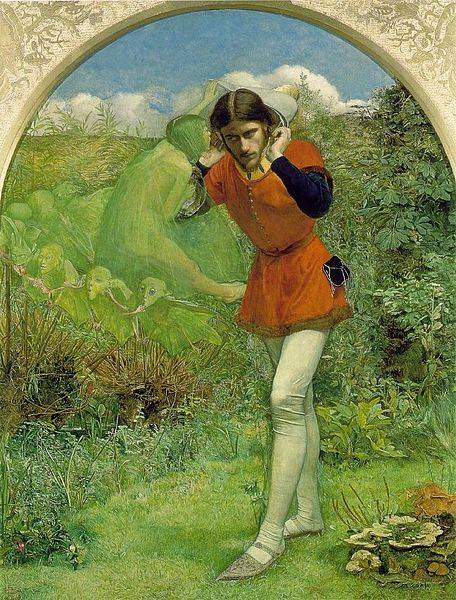1850 - 1861
Pre-Raphaelitism

description
Pre-Raphaelites
Pre-Raphaelitism was a revolutionary art movement. It appeared in the early 1850s in England as the opposite of the academic canons and cultural norms of the Victorian era. The concept “before Raphael” suggests that the artists used a light colour palette, characteristic of the paintings of Fra Angelico, Giovanni Bellini and Pietro Perugino.
The emergence of the movement is associated with the opposition of artists in relation to the established norms of academism and with their union in the “Brotherhood of the Pre-Raphaelites.” The brotherhood initially consisted of seven members: John Everett Millais, William Holman Hunt, Dante Gabriel Rossetti, Thomas Woolner, Michael Rossetti, Frederick Stevens and James Collinson.
English critic John Ruskin provided significant assistance in the formation of the Pre-Raphaelites, giving a positive appraisal of their work in newspaper articles, incorporating them into an independent art system and buying their paintings.
Media: oil, canvas, panel, wood. Genres: religious, historical, literary, allegory, landscape. It should be noted that the innovative way of the painting of the Pre-Raphaelites transformed the religious style into a social one – the icon can no longer be hung in the church, it resembles a more subject-themed scene. The landscapes are bright, with biblical moods; each leaf of the bush is distinct. The allegories are characteristic: a cat eating a bird, as the inability to get out of a difficult situation, a dove, as a symbol of innocence, an open window is hope. A special place is given to female images, calm, dreamy, aware, detached, with beautiful figures and well-groomed hair.
The painting of the Pre-Raphaelites had an impact on graphics (book illustrations), interior design, photo, architecture and landscape design.
Similar art movements: Victorian fairy-tale painting, aesthetics. It significantly influenced Symbolism and Art Nouveau.
Key ideas:
– The main difference from the paintings of modern masters of that time, whose works were dark and gloomy (many of them used bitumen) – is painting on light soil, applying a double layer of zinc white and using translucent paints. This made the palette light and bright. An amazing fact is that the primordial brightness of the pictures of the Pre-Raphaelites has been preserved to this day. The life interpretation of plots is naturalistic.
– The paintings of this movement are characterized by the aesthetic equality of the artist and the model, the model and the character. For example, peasants dressed in appropriate outfits were models for portraits of nobles.
– The Pre-Raphaelites were adherents of painting from nature. They posed for families, relatives, friends and neighbours.
description
An English painter and illustrator, close to the Pre-Raphaelites in spirit, one of the prominent representatives of the movement "Arts and Crafts".He was famous for his stained glass; also, he worked in other crafts: designed jewelry, ceramic tiles and tapestries. He was knighted (1894), supported the ideas of the Pre-Raphaelite Brotherhood and the Aesthetic Movement.
1833 - 1898
description
Thomas Cooper Gotch was an English artist, a prominent representative of the first wave of a famous creative colony - the Newlin School of painting.Born into a Victorian well-to-do family of a middle class, was the fourth son. His family members were engaged in the production and sale of shoes, and Thomas worked for some time in the shoe store after school.He was elected a member of the Royal Academy of Arts, became the organizer of the School of Applied Arts (Newlin Industrial Classes), which trained teenagers from the surrounding villages, a founding member of the Royal British Colonial Society of Artists, and also participated in the creation of the New English Art Club. Apart from the plot paintings, he created portraits, which brought the greatest income, and landscapes, illustrated books.
1854 - 1931
description
Walter Crane is an English painter and graphic artist, illustrator, designer, writer and publicist. Walter Crane achieved popularity as a children's book illustrator, talented not only in illustrating novels of classics but also his own works.The first teacher of the artist was his own family member - his father Thomas Crane, who professionally studied painting and was known as a wonderful miniature master. In his father's studio, Walter took his first steps in the visual arts, drawing numerous portraits, scenes from everyday life, nature - everything that surrounded him. Noticing his son's ability to paint, he sent him to study at the engraving workshop of William Linton, whose radical moods influenced the worldview of the beginning artist to a large extent. In particular, made him interested in socialist ideas.The artist was engaged in the design of several magazines, created sketches of tapestries, textiles, carpets, mosaics, ceramics and stained glass. He was a manager of the exhibitions of the Society of Arts and Crafts, which had a great influence on the development of applied art and design throughout the world. Crane was also engaged in teaching, wrote several scientific works in the field of design, which were in high demand throughout Europe. Since 1898, the artist held a responsible post as a head of the Royal College of Art in London. The artist's works are in the Louvre; the Uffizi Gallery (Florence) ordered him a self-portrait.
1845 - 1915
